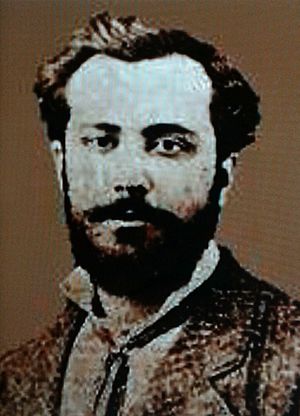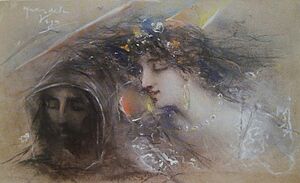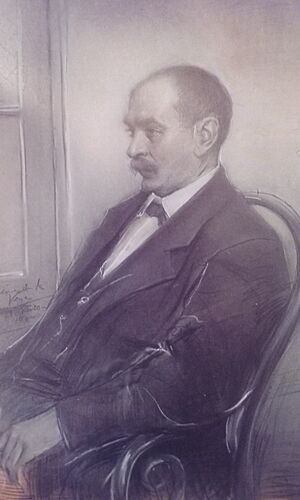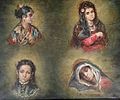Joaquín Martínez de la Vega facts for kids
Joaquín Martínez de la Vega (born 23 June 1846 – died 4 December 1905) was an important Spanish painter and illustrator. He was born in Almería and studied art in Madrid. Even though he wasn't born in Málaga, he is known as a member of the Málaga School of Painting.
Martínez de la Vega was a very creative artist. He became friends with young Picasso and was a lifelong friend of José Denis. His later artworks were very modern for his time. They showed new European art styles like symbolism and post-impressionism. Some of his famous works include his pastel drawings of The Temptations of St. Anthony. He also painted religious scenes like Ecce Homo and Dolorosa. He even designed posters for the Feria de Agosto festival.
Contents
Early Life and Art Studies
Joaquín Martínez de la Vega was born in Almería. His parents, Fernando Martínez de la Vega and Carlota Cisneros Bonifaz, were from Málaga. When Joaquín was 15, his family moved to Córdoba. There, he began studying art at the city's Institute.
He was a very talented student. The next year, he was asked to illustrate an album for Queen Isabel II. As a reward, he received a scholarship to study art in Madrid. This scholarship gave him 1000 pesetas each year.
In 1863, Joaquín moved to Madrid. He joined the Royal San Fernando Academy. This was the best art school in Spain at that time. He studied there for three years with Federico de Madrazo. From Madrazo, he learned to admire Velázquez. He also learned a clear drawing style and how to use colors carefully. During these years, he sent copies of Velázquez's paintings back to Córdoba, as required by his scholarship.
In 1866, he received another scholarship. This one was for 3000 pesetas to study painting in Rome. However, he never went to Rome. The scholarship was canceled after his father passed away.
Career and Personal Life
In 1869, Martínez de la Vega moved to Málaga. He quickly became friends with the painter José Denis. He also joined the local art groups. His fame grew when he won a medal at the 1871 National Exhibition in Madrid. His winning painting was called A Beggar.
In 1875, he started teaching drawing and color at the Málaga Lyceum. Some of his students became famous painters, like Reyna Manescau. During the late 1870s and early 1880s, he became well-known in Málaga. He was a popular portrait painter. He also taught drawing privately to wealthy families. Málaga was a busy industrial city at this time.
Unlike some other painters, Martínez de la Vega did not try to become famous across Spain or internationally. He stopped sending his works to national exhibitions. In 1882, he became an assistant teacher at the Málaga School of Fine Arts. This happened even though he had public disagreements with Bernardo Ferrándiz, another important painter.
On April 30, 1885, he married María Dolores Casilari Bailón. They had a daughter the next year. During this time, he focused on his art. He painted Vamos o No Vamos for the Málaga Lyceum. Sadly, his daughter died before her first birthday. This made the artist very sad. The couple decided to move from Málaga. However, Joaquín's application for a teaching job in Seville was not accepted in 1892. In early 1893, his wife María Dolores also passed away.
Martínez de la Vega was deeply affected by the loss of his family. However, these personal challenges changed his art. He began to explore new themes and styles. After his wife's death, he focused on religious paintings. He created a series of Ecce Homo paintings and paintings of the Virgin Mary (Dolorosas). These are considered some of his best works.
In 1894 and 1895, the city council asked him to create posters for the Feria de Agosto festivals. The 1895 poster, called Carmen, la más fea de mi tierra (Carmen, the Ugliest in my Hometown), is one of his most famous works.
In 1897, he met Pablo Picasso, who was sixteen years old. Martínez de la Vega immediately saw Picasso's great talent. He organized a special event for Picasso at the Málaga Lyceum. There, he and José Nogales playfully "baptized" Picasso with champagne, calling him a new master.
Over time, Martínez de la Vega became less popular in Málaga society. He lost many of his private lessons and most of his income. On September 19, 1900, he married Pepita Cestino Utrera. She was a young woman from a rich local family. However, she left him on their wedding night and returned to her family. She never married again and lived to be 78.
With very little money from his assistant teacher job, he lost his house. He had to move into a small place provided by his friend José Denis. His later paintings became very symbolic and less detailed. It is said that he would pay his bills at local taverns with drawings on napkins. Martínez de la Vega was found dead in his room on December 4, 1905. He was 59 years old.
Art Style and Techniques
Martínez de la Vega was known for bringing new ideas to the Málaga School of Painting. He was very connected to the new art styles happening in Europe at the time. Since he didn't travel much, experts believe he learned about these new styles from art magazines. He also learned from other artists who traveled more. Throughout his career, he did not paint landscapes, which were popular then. He also avoided traditional storytelling in his art.
Experts divide his art career into three main periods:
- Early Period (1863 to 1877): In this time, he was influenced by his teacher, Federico de Madrazo. He developed a romantic style. His drawings were very careful, and his art had a classic composition. He liked romantic themes more than historical ones. His portraits were influenced by Madrazo and Velázquez.
- Middle Period (1877 to 1888): During these years, Martínez de la Vega was influenced by other Málaga School artists, like Denis and Ferrándiz. He created orientalist paintings, which were inspired by the art of the Middle East and Asia. These were similar to the works of Fortuny, whom his friends in Málaga admired. He also continued to paint religious scenes and many portraits using similar techniques.
- Late Period (1888 to 1905): This was a very important time for his art. He went through a difficult personal period, which changed his style a lot. He started using new techniques and themes. After his wife died, his religious paintings became more spiritual. Some experts say his art became similar to pre-raphaelism. These religious paintings slowly changed into symbolism and post-impressionism. He started using pastels as his main art material. He also stopped drawing careful lines and developed a more sketchy style. This was like other post-impressionist painters such as Toulouse-Lautrec. In his later portraits, like the Portrait of D. Joaquín Inglada Torregrosa, he placed his subjects in everyday, personal settings instead of formal ones.
Gallery
Images for kids
See also
 In Spanish: Joaquín Martínez de la Vega para niños
In Spanish: Joaquín Martínez de la Vega para niños

















